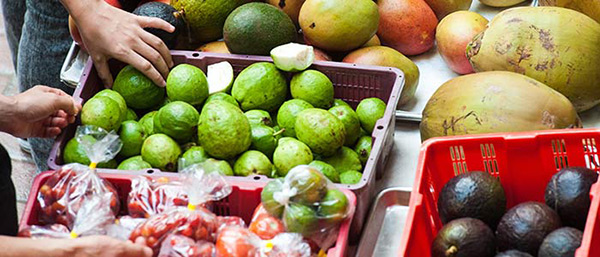
Hawaiian tourist are mesmerized by the unique natural treasures each island has. The tropical landscapes are filled with dense rainforests, bamboo jungles and unique tropical flowers. Along with the wild vegetation, are manicured fruits and vegetable farms. The countless parcels of cultivated land, dotting the Hawaiian landscapes, are not indigenous to the Aloha State.
There are very few native Hawaiian food source plants. The majority of the traditional plant based foods, were brought into the state by the early migrating Marquesans and Tahitians. As far back as 300 to 500 AD, the food staples of taro, kava, sugarcane, breadfruit, bananas, sweet potatoes and coconuts were brought in by the canoeing Polynesians. The early immigrants introduced and planted over 30 food based items in Hawaii.
Other food imports were brought in by the English, Portuguese, Chinese, Filipino, and Japanese. Whaling ships, Christian missionaries and sea voyages, carrying European immigrants, brought in large amounts citrus, fruit trees, seedlings and nutritional staples to sustain long journeys. They were planted and thrived.
The year round climate and rich volcanic soil were ideal growing conditions for endemic and transplanted agricultural items. Most cultivated fruits and vegetables directly reflects the varied Hawaiian cultures.
Hawaiian Tree Fern
The indigenous Hawaiian tree fern or Hāpuʻu ʻiʻi, is a large native plant found in the dense jungles throughout Hawaii. It’s edible young fronds and trunk were boiled or cooked in an imu, an underground cooking method. Ancient Hawaiians often paired the cooked Hāpuʻu ʻiʻi fronds with fish, taro and poi. The fern was also used for its medicinal benefits.
The tree ferns medicinal qualities were released when the cooked fronds and trunk were combined with ginger, kava, turmeric and other herbs to create a medicinal elixir. It’s analgesic benefits were used for rheumatoid stiffness, chest pain, muscle aches and other maladies.
Kalo
The Hawaiian term for taro is, “kalo.” The arrowleaf taro is a tuberous plant that grows well in swampy and well irrigated environments. When harvested, the entire plant is consumed. Many Hawaiian inspired entrees feature the leaves, stem and bulbs.
The taro’s bulb is known as the “corm”. Poi, a primary food source for Hawaiians, is produced from the cooked corms. The bulbs turn purple once they are cooked. The kalo is pounded and blended with water to form a thick light purple porridge. The consistency depends on the ability to consume the poi with one, two or three fingers. Poi is accompanied as a side dish with fish and pork. Its often included at luau’s and with many local entrees.
Ancient Hawaiians believed poi was filled with, “mana,” an energy life force. Poi was known as “the food of life.” Therefore, the consumption of taro, especially as poi, is a communal and spiritual experience. The poi bowl was placed as the sacred centerpiece of the family dining ritual.
Kalo can be roasted, baked, steamed and boiled into amazing sides, salads, breads and desserts. The large arrow or heart shaped leaf, is also prepared into stews and lau lau. Lau lau is a ti leaf wrapped parcel stuffed with chopped taro leaves, pork and butterfish. The preparation of the traditional entree is time intensive and served at most Hawaiian celebrations.
Taro requires careful preparation. The plant contains oxalic acid which develops sharp crystals of calcium oxalate. The raphides or sharp crystals are toxic and can injure the kidneys. The leaves and corm are cooked twice to reduce the amount of raphides.
The cleaning and cooking methods, of the complete plant, are important to the success of the recipe. The first cooking methods requires the cleaned leaves and bulbs to be soaked and boiled. After the boil, the water is discarded. The corm and taro leaves are thoroughly rinsed before the completion of the second cooking.
Fermented poi has medicinal qualities that aid in digestion and gastrointestinal diseases. The nutritional benefits of poi include probiotics, high dietary fiber, calcium, potassium, vitamins, enzymes and minerals.
Daily consumption of fermented poi stabilizes blood sugar in diabetics. Individuals recovering from surgical procedures, lactose sensitivities, celiac disease, irritable bowel syndrome and colon cancer benefit from poi’s hypoallergenic, gluten free and digestible proteins. The ease of digestion and quality proteins are ideal for baby food and soothing colicky babies.
Okinawan Yam
The Okinawan yam is a deep purple root vegetable. The yam also known as, “ube,” was transported to Hawaii by ancient Polynesians between 300 to 500 AD. Over centuries of thriving in the nutrient rich volcanic soil, the yam has evolved as a Hawaiian food staple.
The versatile Okinawan yam is boiled, roasted, fried and baked. It’s also added as a natural sweetener and coloring to ice cream, custards and pudding. The violet purple yam adds a beautiful presentation to mashes, breads, chips and pastries. It’s versatility extends beyond the dining table.
The Okinawan yam is a quality source of Vitamin A, iron, manganese, dietary fiber, potassium and Vitamin C. It’s considered a superfood with superior antioxidant, antibacterial and antifungal qualities.
It’s benefits include lowering cholesterol, stabilizing blood sugar, prevent cardiovascular diseases, reduced inflamed hemorrhoids, fevers and cancer. The Okinawan yam has been used to rid intestinal parasites and as a laxative. It’s vibrant color is used as a natural food coloring and pigment.
Eggplants
The Hawaiian eggplant is a long and slender vegetable. More commonly known as, “Asian or Japanese” eggplants. The color ranges from soft lavender to rich purple. Some eggplant varieties are striated. The length, of the virtually seedless eggplant, is over a foot long. It’s thickness is up to two inches.
It’s believed that the eggplant came from India and China. The eggplant was later introduced, by the Arabs, to the European countries in the 13th century. Due to a close relationship to poisonous plants, early Europeans were fearful of consuming the eggplant.
The eggplant comes from the Nightshade Solanaceae species. Due to its relationships with the toxic Belladonna and Devil’s Snare, was once known as, “mad apple.” Although mature eggplants are deemed safe, the young unripe vegetable is poisonous. Today, the ripe eggplant is cultivated and enjoyed throughout the world.
The eggplants are a daily food staple in the Hawaiian, Filipino and Chinese communities. Many home cooks have infused the eggplant into their favorite recipes. Cooking methods include grilling, baking, sautéeing and stir frying.
The Asian eggplant does not require peeling, but many recipes call for this preparation process. The skin is thin and the spongy flesh is mild to sweet. It’s prepared with tofu, chicken, fish, beef or pork. The flavors of fresh herbs, garlic, ginger, curry, sesame, patis and soy sauce are added to enhance the entrees.
The nutritional benefits of the Japanese eggplant is high in Vitamin A, low calorie, high dietary fiber, rich in niacin, potassium, iron, folate, and Vitamins B and C. It’s has antioxidant qualities of reducing cholesterol, supporting brain health, cardiac health and guarding against cancers. Eggplants also have phytochemical benefits of reducing cell damage.
Farmers Market
Vacationers will experience cornucopia of unusual vegetables, brought in by the immigrants that made Hawaii home. A trip to the local farmers market brings together the unusual range of edible vegetation. Along with sampling, vendors are happy to share recipes and cooking methods.
Favorite plant starters are often sold for local home gardens. Due to possible contamination of plant diseases and pests, out of state visitors are restricted from transporting germinated plants into the United States and other parts of world.
Agricultural Limits
Visitors to the Aloha State must declare plants, fruits, vegetables and flowers before leaving the islands. In fear of introducing damaging pests and diseases to agricultural communities. The USDA and the Animal and Plant Inspection Services prohibits the movement of restricted items into the 48 contiguous states, Alaska, Guam and neighboring islands. They inspect every piece of luggage before issuing flight boarding passes.
Undeclared items can lead to imprisonment and/or fines. Visitors can inquire more about agricultural limits with their resort concierge and airlines. The USDA and island specific websites provide in depth information and export guidelines.
Lasting Memories
Enjoy the tastes of Aloha through a multicultural culinary experience. Savor traditional entrees and exciting flavors presented and prepared using locally grown vegetables and ingredients. Embracing the agricultural history, highlights Hawaii’s cultural melting pot. Their culinary influences, have etched the food memories of your Hawaiian journey, with every flavorful morsel.
